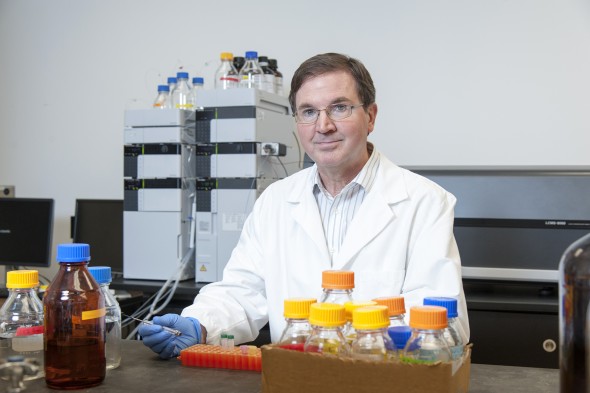Can natural products help prevent, treat disease?

Richard van Breemen: “I hope that my research in natural products will benefit public health.” — Photo: Roberta Dupuis-Devlin
When browsing the aisles at a health food store, Richard van Breemen doesn’t see many botanical dietary supplements that he doesn’t know about.
He doesn’t sell the products, but he studies them.
A natural products specialist, van Breemen is director of the UIC/NIH Center for Botanical Dietary Supplements Research, one of only three botanical centers supported by the National Institutes of Health. In 2015, the center received a new five-year $9 million grant to continue its research of botanical dietary supplements for women’s health. UIC’s center has had continuous NIH support since 1999.
The botanical center investigates natural cancer chemoprevention agents and the safety and efficacy of botanical dietary supplements, especially those used by women as alternatives to hormone therapy and menopause. Van Breemen uses advanced mass spectrometry to trace the active ingredients in dietary supplements from the health food store to the bloodstream. Among the plants that have been or are currently being studied are black cohosh, red clover, chasteberry, valerian, hops, licorice and dong quai.
“The majority of drugs and supplements in use today are derived from natural products,” said van Breemen, who is also professor of medicinal chemistry and pharmacognosy. “This should come as no surprise, as nature has already preselected these substances for bioactivity.
“Now that most major pharmaceutical companies have abandoned their natural products drug discovery programs, our search for new natural pharmaceutical agents has become even more imperative.”
In the United States, 20 percent of adults report using botanical dietary supplements, while in developing countries, supplements and traditional medicines are often the primary sources of health care for disease prevention and treatment.
A pioneer in the field of liquid chromatography-mass spectrometry, van Breemen had little experience working with natural products until he was approached in the late 1980s by researchers asking for his assistance in identifying and measuring carotenoids, chlorophylls and phospholipids in plants and plant cells. Little did he know at the time that his career would take a different path.
“I hope that my research in natural products will benefit public health,” he said.
Through his individual and collaborative efforts, van Breemen has authored or co-authored more than 300 peer-reviewed publications and books, and has secured three patents for his work. He has also mentored 53 graduate students and 21 postdoctoral research associates.
